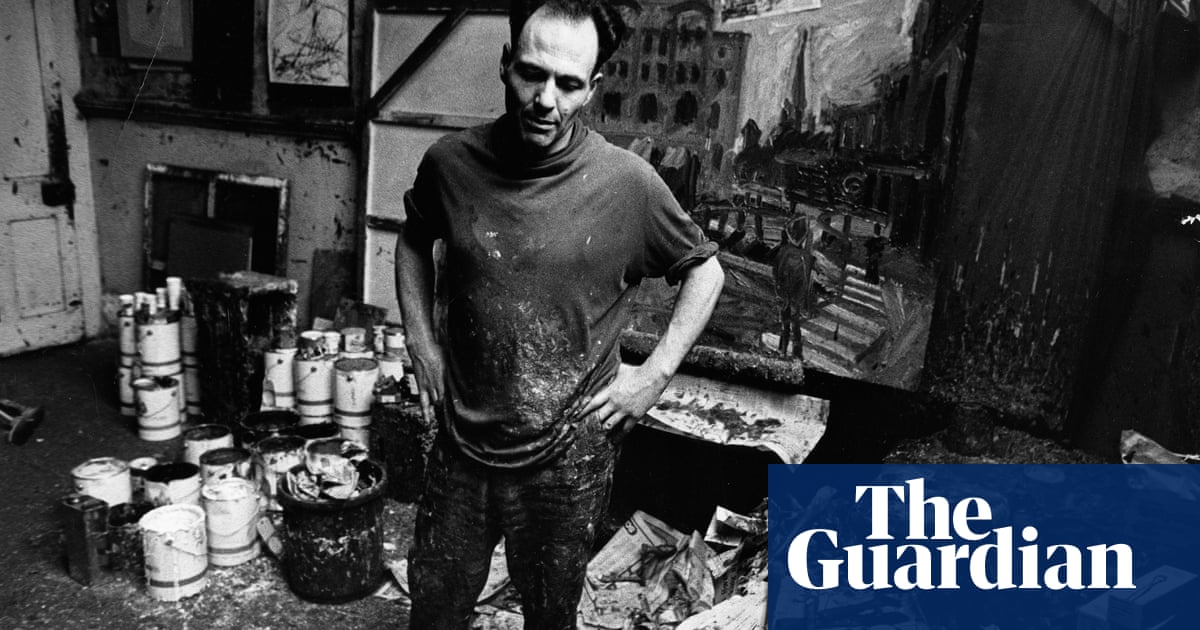
Old age is relative. When Rembrandt painted his Self-Portrait at the Age of 63, showing his pummelled, bankrupted, bereaved face, he looked ancient. He died that year. All his self-portraits as an “old man” were done in his 50s and early 60s. Frank Auerbach, by contrast, will be 92 this month. He is marking the moment with an extraordinary series of self-portraits that examine his face with such relentless honesty, he’s like a 21st-century Rembrandt.
Auerbach has said that he never used to find his own head visually interesting – but “now that I’ve got bags under my eyes, things are sagging and so on, there’s more material to work with”. In these 20 paintings and drawings – many finished in the early months of this year – he makes the most of that saggy material. Over a soft-shaded pencil drawing of his walnut-like phiz, jagged lines are added like time’s graffiti. In another, the flesh is almost invisible under a network of disembodied wrinkles. One painting suggests the shadowy features of a skull, yet from its depths a fire-red eye blazes.
Auerbach returns here to the strange ritual of self-portraiture that was established when Renaissance artists such as Albrecht Dürer, Sofonisba Anguissola and Parmigianino placed a mirror before themselves and studied what they saw: these are the purest, freshest self-images possible, not self-mythification but self-scrutiny. The results of Auerbach looking in the mirror are wondrously strange. He doesn’t seem sure if he even knows the man it reflects. In one drawing, he tilts his head up with pride and even aggression, the eyes narrowed sceptically: who do you think you are looking at?
Who indeed? That is the question. Every one of these portraits appears to be a different person. Looking honestly, Auerbach doesn’t see “Auerbach”, doesn’t portray a comfily familiar face. He sees lines, bumps, folds, ridges – one painting shows a bloody fist of a face, florid reds on a mustard background, barely resolving into coherent features at all. It’s got nothing in common with the white-haired square block of blue and pink flesh seen in another painting.
Auerbach has a long, successful career to look back on, yet there is nothing complacent or reassuring about these desperate images. His self-portraits as a nonagenarian display the same radical anxiety as his youthful art made in the shadow of the second world war. In the 1950s and 60s, while others were discovering pop art, Auerbach was painting the muddy pits of London building sites and faces plastered into existence from masses of slimed pigment: gothic, savage images of life dragging themselves out of the ruins of a shattered Europe.
He is still seeing things, in this case himself, with that existential intensity. One head, held high, has terrible scars scoured across its gentle features: the metaphorical cuts and wounds made by life’s blows. There seem to be capital letters brutally written over the mouth: is that an F for Frank? Another face has cartoon dots for eyes in a brown clay-like morass, with a hand anxiously touching his cheek.
There is almost a compassion for himself or, rather, for the man in the mirror. His features are tender, kind, vulnerable. The eyes – shown as slits, specks, even stars – are myopic with age, though these works show that they can see more than most, deeper than most. After a while you don’t just admire their artfulness but feel the presence of the person they portray – and, as with Rembrandt gazing across the centuries, that person is not a famous artist, but a fragile everyman. That being haunts the gallery, a ghostly, breathing presence – the miracle of a living consciousness.
Auerbach draws and paints with heft: he makes the physical existence of a head so tangible. Looking at one of his painted faces is like holding a pineapple. Not only is it heavy but the spiky protrusions catch your flesh. Yet the power with which he materialises his physical being leads the mind to something beyond – to his emotional presence. This old head is full of mystery. So, you see afresh, are all the people on the streets after leaving this exhibition. The best art opens your senses and imagination to life. Auerbach’s self-portraits strip away all social masks to reveal our universal vulnerability. These paintings have the pared-down truth of Giacometti’s sculptures.
There is triumph here – and tragedy. Auerbach sees something marvellous at 90-plus, as Rembrandt wondered at his face at 63. To still be painting in your 90s is a considerable achievement. To be doing so with such energy and insight is the stuff of greatness.












